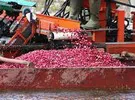 This year’s cranberry crop has improved over last year’s. However, not as much as growers had hoped for. Following last year’s disappointing crop, the August forecast for this year predicted higher numbers. “The indication is that the “breadbasket” of cranberries, Wisconsin, was a little disappointing with an early estimate of 4.3-4.5 million barrels. Our preseason estimate was 5.3 million barrels,” says Bob Wilson of The Cranberry Network, LLC, which represents the Cranberry Cooperative of the Americas. “With final numbers scheduled to be reported in January, it will be better than in the prior year. However, our industry was coming into this season with the lowest stocks we’ve seen in many, many years.”
This year’s cranberry crop has improved over last year’s. However, not as much as growers had hoped for. Following last year’s disappointing crop, the August forecast for this year predicted higher numbers. “The indication is that the “breadbasket” of cranberries, Wisconsin, was a little disappointing with an early estimate of 4.3-4.5 million barrels. Our preseason estimate was 5.3 million barrels,” says Bob Wilson of The Cranberry Network, LLC, which represents the Cranberry Cooperative of the Americas. “With final numbers scheduled to be reported in January, it will be better than in the prior year. However, our industry was coming into this season with the lowest stocks we’ve seen in many, many years.”
There also seem to be varying reports regionally across North America. The next largest growing region, Quebec, Canada, is set to potentially have its best year ever while the following region, Massachusetts, is estimated to have realized an average year with 1.9-2 million barrels. “Other producing regions are significantly smaller but they’re reporting disappointing results, particularly Oregon. Overall it’s not bad but it’s still disappointing because it’s well below expectations,” says Wilson.
Demand staying strong Meanwhile, demand continues to be strong for cranberries, a product that has a health halo over it and saw significant jumps in demand during the peak of COVID. The industry also continues to promote this fruit, an indigenous item for North America, outside of North America to regions less familiar with the fruit. “Throughout Europe, there’s good, mature demand for cranberry products, fresh and processed. In the last decade the industry has also invested in marketing to other regions such as China and India,” adds Wilson. Outside of North America, there is a pocket of production in Chile and some small cultivated cranberry production in Poland and other parts of Eastern Europe and wild cranberries are also growing in Siberia.
Meanwhile, demand continues to be strong for cranberries, a product that has a health halo over it and saw significant jumps in demand during the peak of COVID. The industry also continues to promote this fruit, an indigenous item for North America, outside of North America to regions less familiar with the fruit. “Throughout Europe, there’s good, mature demand for cranberry products, fresh and processed. In the last decade the industry has also invested in marketing to other regions such as China and India,” adds Wilson. Outside of North America, there is a pocket of production in Chile and some small cultivated cranberry production in Poland and other parts of Eastern Europe and wild cranberries are also growing in Siberia.
All of this means cranberry prices have come up. “Cranberry pricing for the better part of a decade and more had been extremely depressed and it was reflected in the returns to growers. It was a lousy oversupply situation, particularly in cranberry juice concentrate, but that has improved over the last four to five years,” says Wilson. He adds that there has been, and continues to be, work on variety development in cranberries, particularly on farmer-friendly developments such as yield improvement or pest-resistant varieties.
 Meanwhile, on the fresh market, a side of the business that only accounts for approximately three percent of cranberries harvested, it’s also having a strong year in terms of demand. “We’ll pack fresh cranberries for another 2.5-3 weeks all the way up to mid-December. But supply is not infinite so we tell consumers to get them when they see them on the shelf,” says Wilson.
Meanwhile, on the fresh market, a side of the business that only accounts for approximately three percent of cranberries harvested, it’s also having a strong year in terms of demand. “We’ll pack fresh cranberries for another 2.5-3 weeks all the way up to mid-December. But supply is not infinite so we tell consumers to get them when they see them on the shelf,” says Wilson.
 For more information:
For more information:
Bob Wilson
The Cranberry Network, LLC
Tel: +1 (715) 422-0410
bwilson@thecranberrynetwork.com
http://thecranberrynetwork.com/
